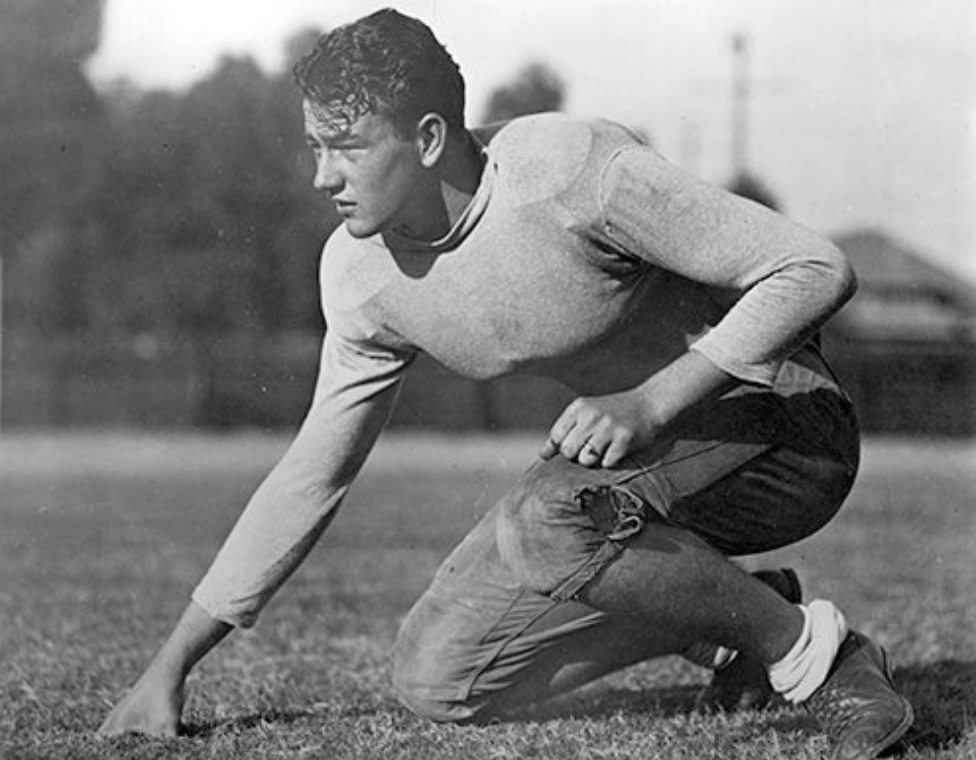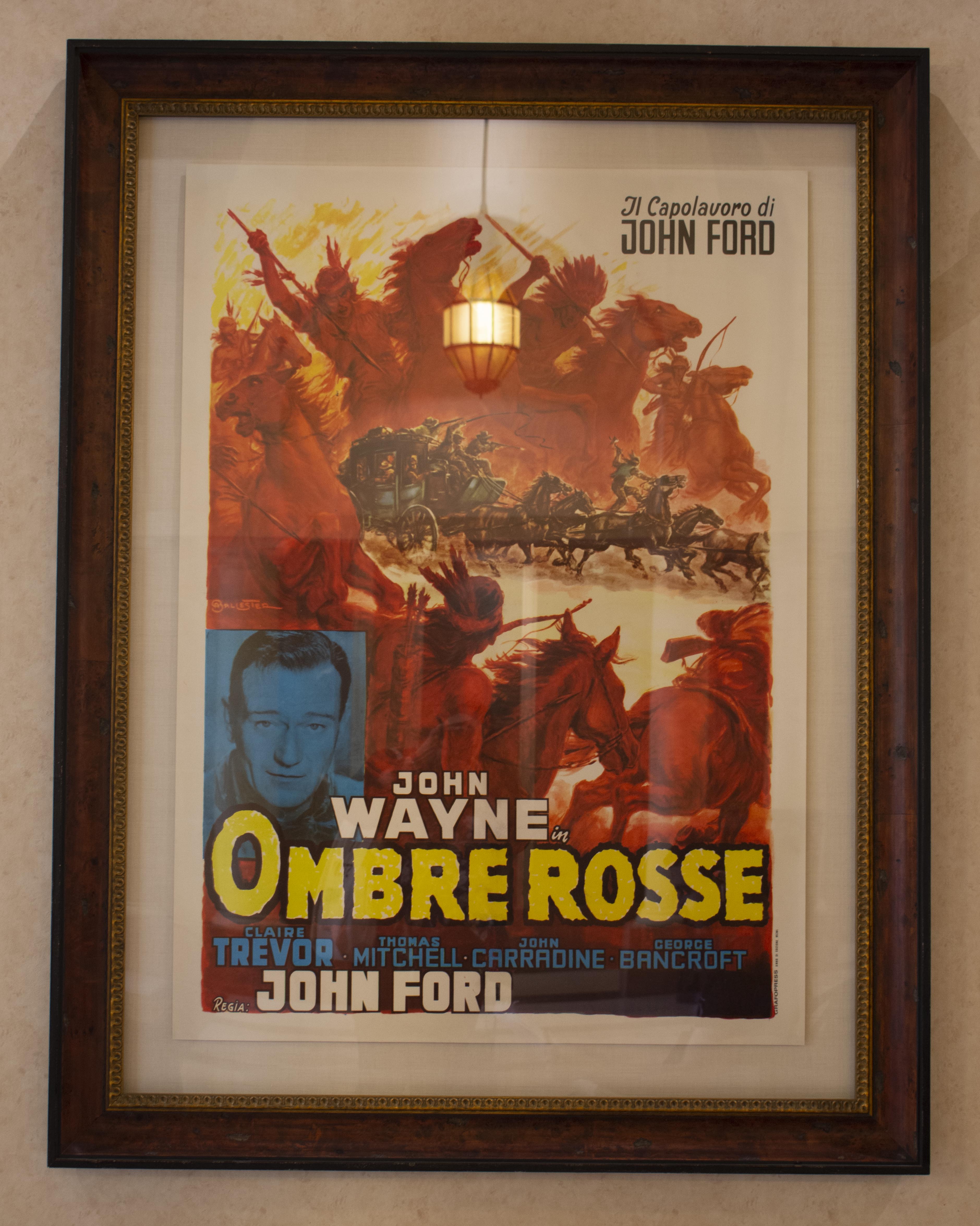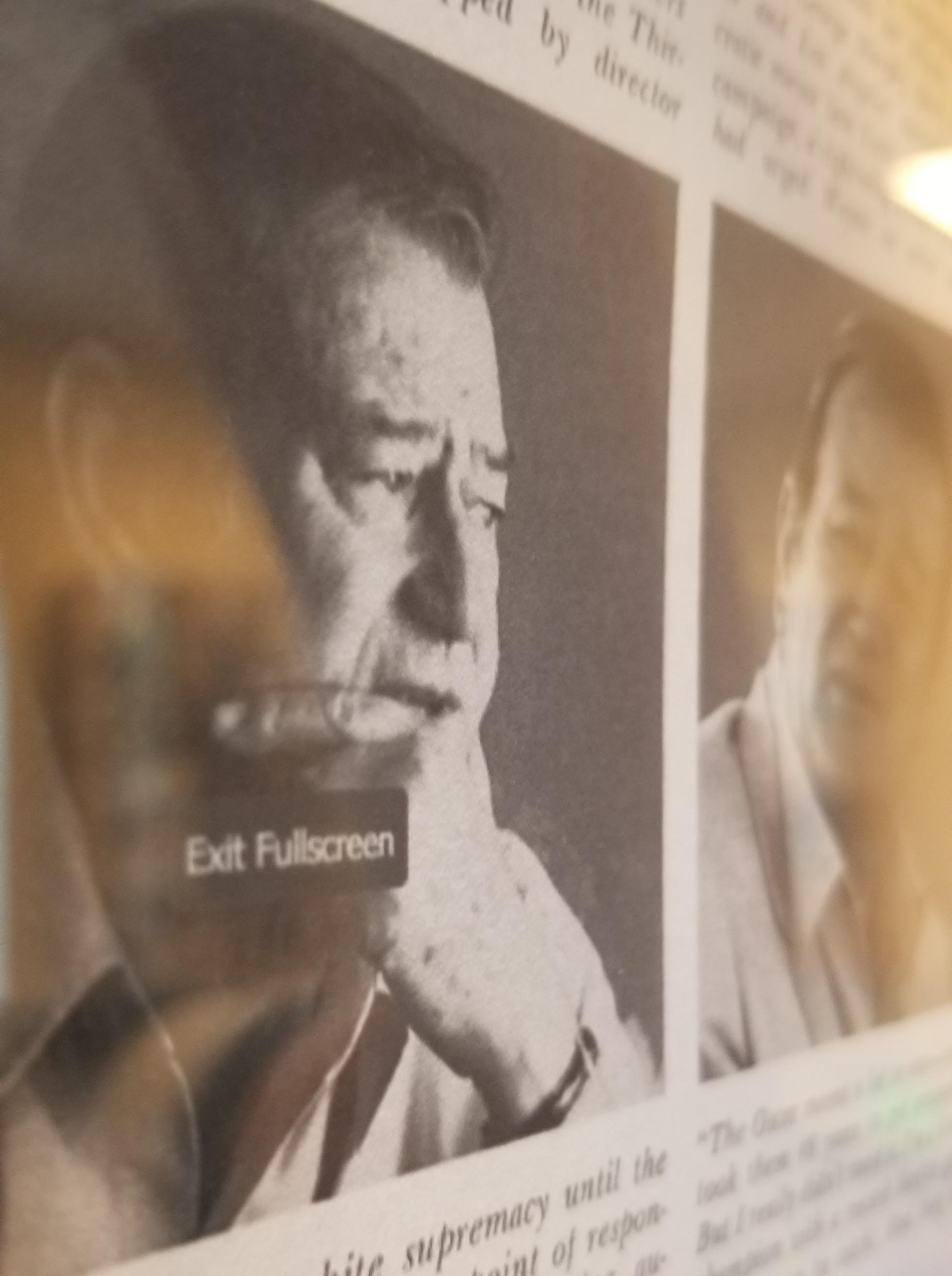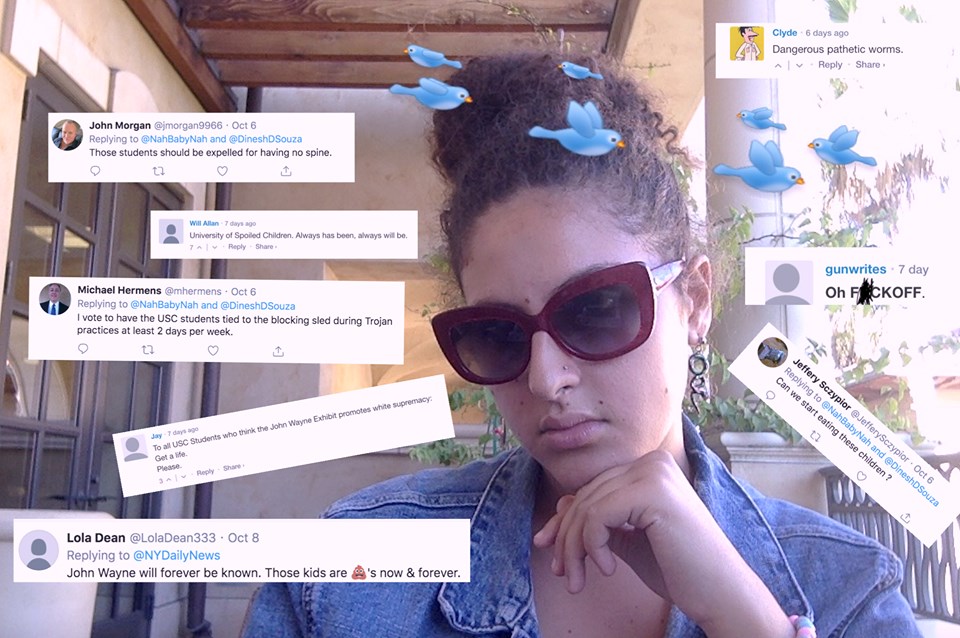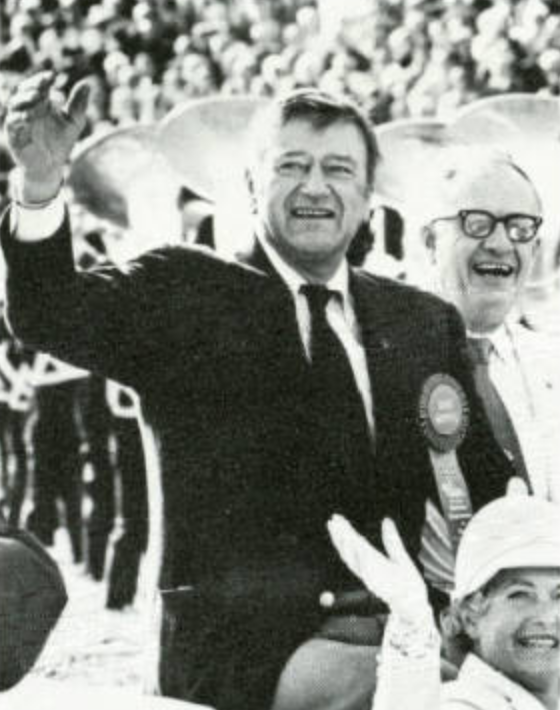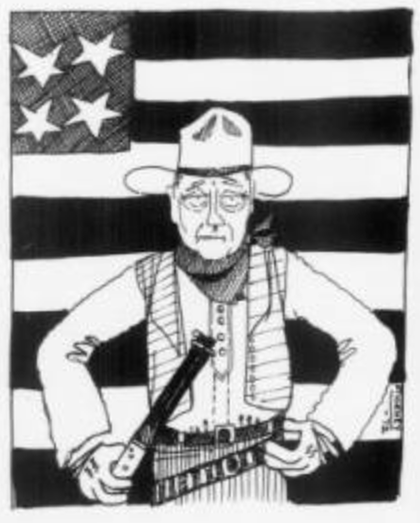Cinema School's Dedication to Wayne proves problematic with students
“Tomorrow is the most important thing in life...It hopes we learned something from yesterday,” is embossed underneath the depiction of a cowboy riding a horse through a desert. This is the gravestone of John Wayne: actor, film maker, father, philanthropist and Presidential Medal of Freedom recipient. At the University of Southern California, where he attended for three years, he has another title–racist.
Since June of 2012, the USC School of Cinematic Arts (SCA) has had a wing on the second floor of the George Lucas Building dedicated to the legacy of John Wayne. This legacy includes 171 films, a cancer foundation, a museum, an airport and racist, homophobic and xenephobic remarks; prompting students to demand the exhibit’s removal on multiple occasions. Though some say that keeping up the exhibit is a direct endorsement of white supremacy by the school, others argue that the statements were in context of their time.
The halls of the wing are plastered left and right with posters of Wayne’s most famous movies leading to a permanent exhibit filled with momentos, props and costumes from Wayne’s time in Hollywood and at USC. One exhibit case includes Wayne’s USC football helmet and his fraternity class photo. Another holds his director’s chair and famous cowboy boots. The exhibit also includes lounge seating used by students to rest between classes or groups discussing their newest film project.
The creation of a John Wayne exhibit at SCA has been in the works since about 2000, the then head of the Cinematic Arts Library Steve Hanson told The Daily Trojan in 2010. The exhibit is only a small portion of the 27 storage units worth of memorabilia collected by Wayne’s eldest son Michael Wayne–who took over his father’s film company, Batjac Productions. When Michael Wayne died, his wife Gretchen came to own the collection and the company.
Gretchen Wayne went on to donate the items her husband collected and became a generous benefactor of the school–a benefactor is the highest level of the school’s donor network, the Leadership Circle. To become a benefactor, donors must donate $250,000 over a five-year period. “Gretchen & Michael Wayne” is etched into the stone of the complex listing the school’s benefactors and Gretchen Wayne also has a plaque inside of the Steven Spielberg Building listing her as a benefactor.
Donations are also accepted for having a space or item named through the school’s donor campaign; ranging from $1,000 for a chair to $20 million for a stage, lab or building. According to the campaign’s map, the faculty conference room, which is of similar size to the exhibit, costs $750,000.
In 1982, Wayne’s family donated to USC a bust of the actor and $50,000 toward the Trojan Football Alumni club’s John Wayne Memorial Scholarship–a fund that since 1978 has given USC football grads not pursuing professional football careers scholarships for graduate school, according to an archived Daily Trojan article. The bust was unveiled at a football game by Michael Wayne and displayed in Heritage Hall. The Trojan Football Alumni Club also hosts an annual golf tournament that the John Wayne Cancer Foundation sponsors.
A Plant with a Plan
In February of 2019, months before news of the college admissions and George Tyndall scandals put the University under a scrutinous spotlight, a 1971 Playboy interview with Wayne resurfaced online–causing students to demand the removal of the exhibit. Despite the seriousness of Wayne’s comments and him unabashedly saying, “I believe in white supremacy,” the school quickly moved on with the now infamous scandals that rocked the campus. But for USC Roski School of Art and Design student Eric Plant, the exhibit’s existence grew even more bothersome.
Plant never outwardly identified as indigenous. They* struggled with claiming the identity because they didn’t grow up around the culture. But during this past summer break, Eric spent a lot of time with their grandmother, a member of the Yaqui tribe. To communicate more clearly, Eric learned more Spanish and their grandmother learned more English so that she could pass on more of their tribes stories and history.
Plant took a course on the stereotypes of Black people in the media and was encouraged by the professor to research their own culture and how Native Americans are portrayed.
“I have everything on my computer from day one–Columbus–to today," they said.
They became fascinated with how the Western transformed media and its portrayal of Native people.
The John Wayne Exhibit always bothered them, but when the school hosted talks to remove the exhibit back in February, when the interview was recirculated, they thought it would come down–but it didn’t. When the new school year began, they contacted administration and found out that the exhibit’s removal was overlooked.
“It made me so angry. I was really mad at them for having done that. So I made it my mission to have it down by the end of the semester,” they said.
Eric hatched a plan. The mission: to ruin SCA’s image, as they put it. The execution: to hold a big red banner in front of SCA with bold white letters.
What's behind the scenes?
“Wayne’s characters epitomized the role of a white male hero with a gun,” Thomas Gustafson, Associate Professor of English and American Studies and Ethnicity, said.
Gustafson teaches “the Frontier and the New West,” an interdisciplinary course on the American political, cultural and social life with an emphasis on the Western United States. He says that over the years, Wayne’s name recognition has declined, but the influence of his films on the way students think of how the west was won remains.
Tok Thompson, an Associate Professor of Anthropology and Communication who teaches courses on Native American culture, agrees.
“It makes sense to call into question the history of John Wayne in context of indigenous genocide and manifest destiny,” Gustafson said.
It’s at this point Gustafson and Thompson’s opinions diverge.
Thompson traces the history of the Western genre, John Wayne’s success and the origin of Native American stereotypes in media to Buffalo Bill’s Wild West show.
"The wild west as a genre is about the heroic conquering of the new frontier and indigenous communities by a heroic white male. There’s never been a realistic portrayal of how the west was won, but John Wayne epitomizes how we want to think that happened so well,” Thompson said.
Thompson discussed the counter discourse and views of the American Indian Movement and the civil rights movement that Wayne was responding to at that time.
"It was an attitude shared by many. Wayne blurred the lines between his character and his person with that ethos. But Americans needed a way to justify historical conquest and genocide. We like to think we would all be perfect back then, but would we be? The American society is in an age of unprecedented recalibration and we must understand that, by definition, heroes are polarizing. A hero to some is always a villain to others,” Thompson said.
Thompson explained that the “recalibration” of American society largely stems from technological advances.
“We see John Wayne and the western as wrong now, mostly because minority groups can represent themselves now through the internet and social media,” he said. “But there’s no doubt that John Wayne’s legacy is still strong.”
A Virtual Tour of the John Wayne Exhibit
To hear the virtual tour narration, click the tool button in the top right corner and select "turn ambient sound on. To view the tour in full screen, click here
Empty Cowboy boots
Calling John Wayne’s legacy into question is exactly what Plant and Cruz did Sept. 27 with a the banner that read, “SCA must remove the John Wayne exhibit. Wayne is a blatant racist. He promotes the genocide of indigenous American peoples. By keeping Wayne’s legacy alive, SCA is endorsing white supremacy.”
The two were interviewed by numerous outlets and even more picked up the story through newswires. Students and professors stopped in support and some to argue. Cruz recalls one student saying that the exhibit is just “empty cowboy boots.”
“That’s true, but they wouldn’t be up in our school if they didn’t belong to John Wayne. And because his persona is so directly tied with those cowboy boots, those cowboy boots become a symbol of him and they become a symbol by extension of racism, white supremacy and the genoicde of Native people,” Cruz said. “Just because we’re in 2019 doesn’t mean we have to excuse it.”
According to Cruz, the SCA dean, Elizabeth M. Daley, saw the sign as she walked by and asked questions. Cruz said they* felt Daley was interested, but what they did not know was that in 2012, Daley told USC News, “We are honored and humbled to have John Wayne’s legacy and the Wayne family name at the School of Cinematic Arts. None of this would have been possible without the work and dedication of Gretchen Wayne, whose kindness and generosity will live at the school for generations to come,” when the exhibit opened.
Given the controversy, SCA is working to figure out if those generations to come may be cut short.
Interim Assistant Dean of Diversity and Inclusion Evan Hughes issued the following statement: The USC School of Cinematic Arts hosted a conversation with students after a recent protest about the School’s Wayne Exhibit. The forum allowed Cinematic Arts students to voice their concerns about the exhibit and debate John Wayne’s legacy, while the administration asked them to draft recommendations for the display that features the controversial Hollywood icon. Some students called for greater contextualization of the exhibit to include the larger history of the Western genre and plight of indigenous people. Others want to remove the exhibit altogether. One suggestion to include the controversial 1971 Playboy interview in the exhibit will be implemented immediately as a long-term plan for the exhibit is discussed. The exhibit will also include a place where students can post their thoughts and reflections. In the coming weeks the School will be consulting with film scholars, as well as individuals with expertise in archival materials and exhibits focusing on the Western and the American West, to help make a determination about the future of the exhibit. SCA is committed to announcing their decision by the end of the fall semester.
Plant had wanted the exhibit down immediately, but especially before the second annual celebration of Indigenous Peoples Day, which came and went Oct. 14.
At this year’s Indigenous Peoples Day celebrations, Maria Elena Chavez–an SCA alum, daughter of labor leader Dolores Huerta and niece of Cesar Chavez–stood in solidarity with the students.
“I think now is a good time for [the school] to go above and beyond and to really listen to students and be in tune with the community. The fact that they have an exhibit on John Wayne of all the different people in entertainment and media who have had social impact. It’s really not showing that they are learning from past mistakes. This is a great opportunity to teach the administrators and school community about the historical facts about this individual and why it’s important. I know it must be a hard position for his family to be in, but they have to be knowledgeable of the times that we live in and do what they can to not defend what are obvious–words are just as important to the Native community as actions.”
Native American SCA Alum Lucas Brown Eyes agreed that the exhibit needs to come down.
“I find it funny because everyone in my family and community knew he was racist,” he said.
A framed print-out of the Playboy interview was installed in the exhibit Oct. 16. Cruz excitedly texted Plant that it was up and took a photo, but upon closer inspection, they were not impressed. Cruz recalls in the conversation–which they say was unfairly closed to SCA students only–it was brought up that the article would have a caption and highlight the worst parts, but this did not happen. The posted article is clearly a pixelated screenshot. The words “exit fullscreen” are on top of a photo of Wayne in the article.
“Directly challenging this serves to benefit everybody because it’s a conversation of campus safety and campus mental health,” Cruz said.
When Plant and Cruz were unable to hold the banner due to classes, they encouraged students to contact the dean’s office and wrote a script for volunteers.
Cruz and Plant both discussed the University and the school’s history with not removing items in similar cases. Cruz brought up the Bryan Singer Division of Critical Studies controversy, where students amassed over 4,000 signatures to have Singer’s name from SCA removed following sexual assault allegations. They also mentioned that students have been petitioning the school for years to change the name of the Von Kleinsmid Center, named for a eugenicist.
“In a perfect world, I would take it all down. But USC just wouldn’t do that on their own. Students have to be loud and get media outlets involved for anything to get done. They’re too persuaded by money rather than direct care for the students,” Cruz said.
For their work in trying to remove the exhibit, Plant and Cruz have received plenty of violent threats and comments. Commentators have called for them to be expelled from school or have messaged them directly online. Some conservative media outlets have speculated that their acceptance to ‘SC is in response to affirmative action.
But Cruz has found a way to make light of the haters. They photoshopped a selfie to surround themselves in the hateful tweets, making the picture their Facebook header.
“A bunch of these articles make it seem like we hate SCA, but for me, that’s literally not the case. This is my dream school, this is where I need to be. I’m on hefty scholarship to get to go here. And as a first-gen college student; things SCA has given me is literally immeasurable,” Cruz said.
Cruz and Plant have not reported the entirety of the online trolling to administration.
“I like SCA. This is just something that I wish was changed and it’s my right as a student to speak up when I think things are wrong,” Cruz said.
John Wayne's Influence World Wide
John Wayne has many locations named after him. From an airport in Orange County to an elementary school in Brooklyn, the Duke's influence is still strong.
The Storm has Been Brewing
Many chalk up the questioning of John Wayne’s legacy at USC to 2019’s liberalism and cancel culture, but archived issues of the Daily Trojan show the controversy has been brewing for decades.
When Wayne was announced as the Rose Parade’s 1973 grand marshall, the Daily Trojan editorial board released an editorial, entitled “John Wayne–a Racist Grand Marshall,” stating that they felt the choosing of Wayne was offensive. Along with a cartoon depicting Wayne in front of an American flag, the article stated, “We think this is a gross insult to Blacks, American Indians and to Americans of any race who believe in equality.”
The article went on to say that they were not challenging Wayne’s influence on the movie industry or his constitutional right to say those statements. Like Plant and Cruz, the board had to argue that they did not believe challenging Wayne’s statements made them ‘un-American’ as critics would say, but that they felt “that America is far from achieving racial harmony” and that “racism and bigotry should not be rewarded.”
The editorial did not go over smoothly, even in the DT’s own ranks. About a month later and following the parade, writer Bill Saracino wrote an opinion piece for his column “Bill of Right,” in which he said: “The DT bitching about Wayne being Grand Marshall brings easily to mind FDR’s comment about ‘an ant farting in the wind.’” He continued that the DT, in mockery of USC’s fight song, would “Fart on, in banality.”
The original editorial and Saracino’s response set off a chain reaction from alum, students and the country sending in letters to the editor. One published letter's author stated that he agreed with Wayne’s statements, and that the choosing of Wayne as the grand marshall was in conjunction with the parade’s theme that year, “Movie Memories.” The writer compared the acquisition of land from Native Americans to the situation in Israel.
From Duke to Trojan
Wayne, whose birth name was Marion Robert Morrison, attended USC on a football scholarship. He was a member of the Sigma Chi fraternity, a Trojan Knight and a pre-law student until a body surfing accident left him injured his junior year. Unable to play, he lost his scholarship and could not make ends meet financially, even with his numerous jobs. Wayne dropped out of USC, but with the help of his football coach he found work at the Fox Studios. There, he met director John Ford, who grew to admire him and put him on the big screen. After a few flops, he had his first starring role in the 1930 flick, “The Big Trail” and his final, “The Shootist” (1976)–his 171st. Though Wayne never graduated from USC, he was awarded with the University’s top honor for alum and an honorary degree. Shortly before his death, he was awarded the Congressional Gold Medal and after his death, he was awarded the Presidential Medal of Freedom.
Even 37 years after his death, a 2016 Harris Poll found that Americans ranked John Wayne among their top five favorite actors. Wayne is the only actor to never dip below the top ten in over two decades. It’s clear that his influence lives on. But will it continue in Troy?
John Wayne’s son Ethan gave a statement about his father’s legacy: “We really want to encourage students to do more research on John Wayne as a whole and not base their opinion on one article as his actions were nothing like some of the words in a single interview. He hired, worked with and was friends with people of all races, religions, politics and sexual orientations. His three wives were hispanic. He believed everyone should have equal opportunities, and if they were willing to work hard they should have the opportunity to succeed. He believed in the freedom of speech, often saying he may not believe in someone’s views, but he would defend their right to say them to the end.”
